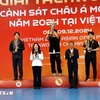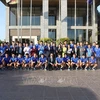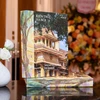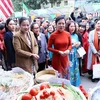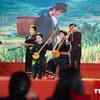For US photographer Catherine Karnow, every corner, person or moment in Vietnam could be inspiration.
Over the past 25 years, Karnow has come to Vietnam many times to take photos and dig into the local culture. Her exhibition, Vietnam – 25 Years Documenting a Changing Country, opened on April 10. It gives visitors an overview of her experiences and feelings during her journey.
"Whenever I come back, I find new stories or something I forgot to cover during previous trips," Karnow said. "I always have a reason to come to Vietnam."
Karnow's photo of people at Sai Gon docks in 1990 waiting for a ferry embodies the feeling of expectation. Her photo of Ho Chi Minh City as seen from Bitexco Tower sums up the city's sparkling night life. She has also captured images of Agent Orange/dioxin victims.
The exhibition is sectioned off by time period. It starts with the early 1990s, and goes on to General Vo Nguyen Giap, the Doi Moi (renewal period), legacies of the war and finally modern Vietnam.
She started photographing Vietnam in 1990 and has returned numerous times for assignments and personal projects.
"My knowledge about and love of the country is profound," Karnow said. "It is an utterly fascinating place, impossible to fully grasp, and always seductive in its mystery."
Karnow's early works in the 1990s were pensive and full of the kind of question a foreigner coming to Vietnam for the first time asks, said Suzanne Lecht, the exhibition's curator.
"Meanwhile, the photos taken in the General Giap years, from her initial visit with the General in 1990 to her historic return to his homeland for his funeral in 2013, are confirmation that not only is she accepted in this land – she belongs," Lecht said.
The Doi Moi works portrayed a country opening its doors to international trade, she continued. The country formed foreign alliances, poised on the cusp of a bright future, and was hailed as the new tiger of Southeast Asia. The Agent Orange victims' photos depicted the sad legacy of war and tragedy for both sides.
In the final section, New Vietnam, photos depict the youth of Vietnam coming forward, blazing with renewed energy and a passion for life.
"This is palpable as we gaze at brazen consumption, exquisite fashion and extravagant lifestyles, all merely a dream a scant 25 years ago," Lecht said.
Karnow was born in Hong Kong and grew up there in the 1960s. She has taken photos around the world over the past three decades for National Geographic. Her father, journalist Stanley Karnow, was the bureau chief for Time-Life and then a foreign correspondent for The Washington Post. He was the author of the seminal book and Emmy award-winning documentary on the country, Vietnam: A History, which changed the way the US regarded the war.
"The exhibition is a tribute to my father, who not only introduced me to Vietnam but also always told me I was carrying on his legacy," Karnow said.
The exhibition will run until May 8 at the Art Vietnam Gallery, 24 Ly Quoc Su Street in Hanoi. It's one of many activities marking the 20th anniversary of the start of diplomatic relations between the US and Vietnam, and the 40th anniversary of the end of the war.-VNA
Over the past 25 years, Karnow has come to Vietnam many times to take photos and dig into the local culture. Her exhibition, Vietnam – 25 Years Documenting a Changing Country, opened on April 10. It gives visitors an overview of her experiences and feelings during her journey.
"Whenever I come back, I find new stories or something I forgot to cover during previous trips," Karnow said. "I always have a reason to come to Vietnam."
Karnow's photo of people at Sai Gon docks in 1990 waiting for a ferry embodies the feeling of expectation. Her photo of Ho Chi Minh City as seen from Bitexco Tower sums up the city's sparkling night life. She has also captured images of Agent Orange/dioxin victims.
The exhibition is sectioned off by time period. It starts with the early 1990s, and goes on to General Vo Nguyen Giap, the Doi Moi (renewal period), legacies of the war and finally modern Vietnam.
She started photographing Vietnam in 1990 and has returned numerous times for assignments and personal projects.
"My knowledge about and love of the country is profound," Karnow said. "It is an utterly fascinating place, impossible to fully grasp, and always seductive in its mystery."
Karnow's early works in the 1990s were pensive and full of the kind of question a foreigner coming to Vietnam for the first time asks, said Suzanne Lecht, the exhibition's curator.
"Meanwhile, the photos taken in the General Giap years, from her initial visit with the General in 1990 to her historic return to his homeland for his funeral in 2013, are confirmation that not only is she accepted in this land – she belongs," Lecht said.
The Doi Moi works portrayed a country opening its doors to international trade, she continued. The country formed foreign alliances, poised on the cusp of a bright future, and was hailed as the new tiger of Southeast Asia. The Agent Orange victims' photos depicted the sad legacy of war and tragedy for both sides.
In the final section, New Vietnam, photos depict the youth of Vietnam coming forward, blazing with renewed energy and a passion for life.
"This is palpable as we gaze at brazen consumption, exquisite fashion and extravagant lifestyles, all merely a dream a scant 25 years ago," Lecht said.
Karnow was born in Hong Kong and grew up there in the 1960s. She has taken photos around the world over the past three decades for National Geographic. Her father, journalist Stanley Karnow, was the bureau chief for Time-Life and then a foreign correspondent for The Washington Post. He was the author of the seminal book and Emmy award-winning documentary on the country, Vietnam: A History, which changed the way the US regarded the war.
"The exhibition is a tribute to my father, who not only introduced me to Vietnam but also always told me I was carrying on his legacy," Karnow said.
The exhibition will run until May 8 at the Art Vietnam Gallery, 24 Ly Quoc Su Street in Hanoi. It's one of many activities marking the 20th anniversary of the start of diplomatic relations between the US and Vietnam, and the 40th anniversary of the end of the war.-VNA












